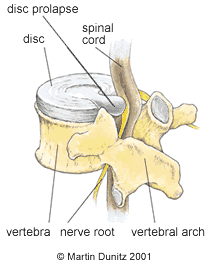| Common Signs & Symptoms | |||||
| Pain | Swelling | Stiffness | Weakness | Instability | Locking |
Sciatica Injury Explained
Sciatica may or may not be accompanied by back pain. Sciatica is a condition where pain, weakness or altered sensation can be experienced in the buttock, hamstring, calf or foot due to irritation of the Sciatic nerve. The Sciatic nerve runs from the lower part of the spine down the back of both legs to the feet, forming what is effectively an ‘electrical cable’ to and from the brain. Sciatica symptoms vary from a mild cramping or tightening sensation in the hamstring or calf muscles (that can be interpreted as the pre-cursor to a strain) to a constant shooting pain in the buttock, hamstring and down to the foot (a phenomenon known as referred pain).
Sciatica is a form of ‘Radiculopathy’ (pain, weakness or altered sensation along the distribution of a nerve) which is usually caused by irritation of a ‘nerve root’ located in the lower back, although there are other causes of Sciatica. Sciatica can seriously affect the health and quality of life of patients and a staggering 40% of people will suffer from some degree of Sciatica in their lifetime.
Although the cause of Sciatica often lies in the spine, not all sufferers will experience back pain and symptoms can be variable. The problem can manifest as back pain with leg pain, or leg pain only. Some sufferers will experience numbness or weakness in their lower limb. Sciatica can be caused by problems with the Facet Joints in the lower back; problems with the Sacro Iliac Joint; or through irritation of the Sciatic nerve in the buttock (Piriformis Syndrome), but the major cause of Sciatica from the lower back is a Herniated Disc (‘slipped disc’).
The discs are located between each of the vertebra that make up the spinal column. These discs consist of a tough outer fibrous layer that surrounds a gel-like nucleus centre. Repeated over-use during prolonged sitting, bending, lifting, and sporting activities can lead to degeneration of the outer layer of the disc. If this degeneration is sufficient, the nucleus material is liable to prolapse out of the disc.

As the gel material leaks out of the disc, it cannot move directly backwards due to the spinal column and instead will move to the space on either the left or the right of the vertebra. This space (foramen) is where the nerve roots also leave the spinal column, therefore the herniated disc and reduced space can pinch on the nerves, disrupting the signal that is sent to the leg. This pressure on the nerve root may cause sudden and severe pain that can be felt anywhere along the pathway of the particular nerve root that is being obstructed. Most commonly, the nerve roots affected produce pain in specific patterns or distributions which can be diagnosed by a Chartered Physiotherapist. Sciatica can produce pain in the buttock, the hamstrings, back of the knee, the calf or the heel.
Originally the Herniated disc model had been regarded as the sole cause of pain in Sciatica. However, more recent clinical observations have shown that this may not be the case. For example, Sciatica is not present in some patients who have an obvious Herniated disc on an MRI scan. In addition, the severity of Sciatica symptoms is often not related to the size of the Herniated disc. These findings would suggest that other mechanisms apart from mechanical compression may be responsible for the symptoms. Increasing evidence from research studies would suggest that inflammation of areas of the nerve root may be involved.
Sciatica Signs & Symptoms
Symptoms vary from a mild cramping or tightening sensation in the hamstring or calf muscles (that can sometimes be interpreted as the pre-cursor to a strain) to a constant shooting pain in the buttock, hamstring and down to the foot.
In some instances, flexion (bending) of the lower back can increase pressure on the discs and cause prolapsed disc material to aggravate adjacent nerve roots. This means that any bending forwards, such as when putting on or taking off shoes, will typically irritate the problem and lead to a worsening of the Sciatica pain. It is not just bending forwards that can aggravate the problem. Sitting for a prolonged period can increase disc pressure and Sciatica symptoms; so sitting in a theatre or at a desk, or driving often cause discomfort and lead to a flare up in people with Sciatica. Lifting also typically causes irritation of the nerve roots in the lower back. This can be extremely frustrating in people with Sciatica who have young children, as attending to them can aggravate their problem.
The combination of mechanical and inflammatory factors that contribute to Sciatica means that exact diagnosis of the origin of the problem is not always straightforward. An MRI scan of the back can show whether a Herniated disc is present, together with the size and direction of the prolapse from the Herniated disc. However, as mentioned above, the size of a disc prolapse is not necessarily related to the level of pain reported by the patient. Indeed, patients with an obvious Herniated disc on an MRI can have no pain, whilst those with no obvious Herniated disc can have severe symptoms of pain and/or muscle weakness.
For this reason, further diagnostic tests provide valuable information for the medical team. Needle electromyography (EMG) records the electrical activity of muscle fibres. A fine gauge needle is inserted into muscles that are supplied by the Sciatic nerve, in what is an uncomfortable but tolerable examination. Needle EMG feedback can produce findings that suggest a nerve root injury.
Alternatively, Nerve Conduction Studies (NCS) use a non-invasive stimulator to apply a brief electrical impulse to a peripheral nerve, with the response being recorded by electrodes. The velocity of the nerve transmission can be accurately measured, with healthy nerves transmitting the electrical impulse faster than diseased ones.
Anyone with back pain who has any of the following should consult their doctor as soon as possible:
- History of trauma e.g. a fall or car crash
- Aged younger than 20 or older than 55 when you first experienced back pain
- Cancer in the past or present
- Unexplained weight loss
- Prolonged use of Steroid medication
- Immunosuppression / history of IV drug use
- Numbness or weakness in the legs
- Unremitting pain
- Bladder or bowel problems
- Fever
Sciatica Treatment
What you can do
| Consult a sports injury expert | |
| Remain active and apply heat packs for pain relief | |
| Wear a back brace to improve posture & relieve pain | |
| Use a back stretcher to assist the healing process | |
| Exercise with a Swiss Ball to increase lower back muscular stability | |
| Practice exercises to strengthen spine supporting muscles |
Pain-relieving medication and Heat Packs are usually necessary during the first few days following a Herniated disc, but the best available evidence suggests that patients with Sciatica due to a Herniated disc should be advised to remain as active as they possibly can. This is based on the fact that research shows no significant difference between bed rest and staying active, and that there is no evidence that staying active is harmful for either severe low back pain or Sciatica. A Back Brace can be helpful to improve posture and relieve pain in cases of Sciatica that are due to a Herniated disc.
In many cases of Herniated disc, the symptoms can be relieved if the patient gets into a position of spinal extension. Bending backwards can help counter-balance the excessive forward bending and is a key element of rehabilitation of disc herniation. In the early stages of injury, this position may be too painful so should be avoided until it becomes less aggravating. Spinal extension can be achieved by lying on the front and gently propping the shoulders up on the elbows. Alternatively, a Back Stretcher can help achieve spinal extension while the user simply lies down and relaxes. In most cases, this position puts the spine in the opposite position to that in which the injury occurred (spinal flexion or bending) and this encourages the prolapsed nucleus gel to recede into the disc. Once the nucleus material has shrunk back into the disc then the outer layer of the disc will heal with scar tissue.
Although the symptoms of Sciatica normally settle much faster, this healing of the disc can take six to twelve weeks to completely heal and during that period the disc may be vulnerable to re-injury. For this reason, and to reduce the chances of a recurrence, the patient should follow the rehabilitation programme set by a Chartered Physiotherapist. This will involve regaining normal movement in the lumbar spine, improving postural habits and learning how to contract the muscles that support and stabilise the back.
Research has shown that specific back exercises, known as core strength and stability exercises, can be effective in relieving back pain and restoring normal function. These back exercises are most effective where the problem is caused by poor postural habits and the pain resulting from disc problems. The Stabiliser Pressure Biofeedback Device is very useful for learning these specific exercises. Once the correct technique has been mastered under the guidance of a chartered physiotherapist, these exercises are very easy to do. They are not too vigorous and they can be done by people of all ages. More advanced back exercises using a Swiss Ball are also helpful for back pain prevention.
Manual therapy in the form of spinal manipulation has also been shown to be effective in the treatment of disc related problems and Sciatica. This can relieve nerve root compression caused by fibrous scar tissue following a disc prolapse, or the build up of gas (Nitrogen). This gas build up is a consequence of disc degeneration and tends to be more common in those aged over 40.
Most cases of Sciatica tend to settle down with physiotherapy treatment, but severe cases of Sciatica due to Herniated discs may require steroid injections or even surgery. Caudal Epidural Steroid Injections (ESIs) bathe the nerve roots in fluid that reduces inflammation. They can be very effective in relieving the symptoms of Sciatica.
Minimally invasive surgical techniques can be considered when all other treatments have failed to resolve Sciatica and there is unremitting pain. These include spinal decompression where pressure on the disc is relieved or a minimally invasive removal of the disc. Disc replacement is another surgical option, but the long term effects of this relatively new technique are not yet fully understood.


